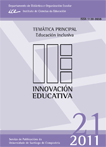No 21 (2011): Inclusive education, Estudos de carácter teórico-investigador
Submitted: 23-04-2012
Accepted: 25-04-2012
Published: 30-04-2012
In this paper we analyze the items of the Bangor Dyslexia Test that best discriminate between dyslexics(n = 355), children with a report of literacy difficulties but no mention of the construct dyslexia(n = 57) and subjects without difficulties in written language (n = 327). Equally, one tries to determinea mathematical equation that allows us to know in what percentage they find the subjects of thesample classified well and to predict the group to which an external case will belong to the same one,knowing only the scores obtained in the independent variables. The results show that the items thatmore they contribute to the differentiation between groups are the b-d confusion, the tables and thesubtraction. Likewise, the information of classification obtained indicates that 91.2 % of the subjectshave been assigned correctly to their original group. From these results, we present suggestions on theimprovement of this instrument of detection of dyslexia.
Dyslexia, Literacy difficulties, Discriminant analysis, Screening test


